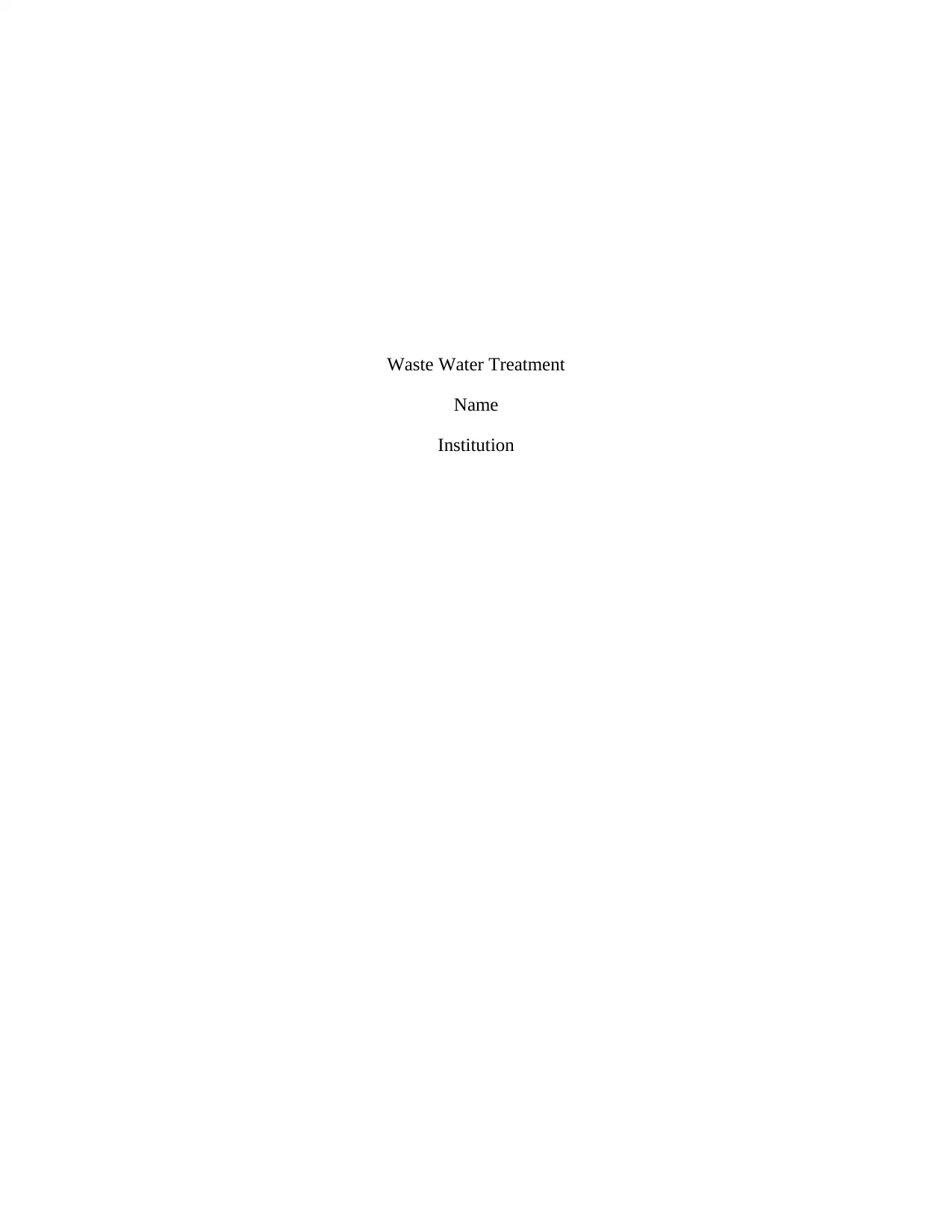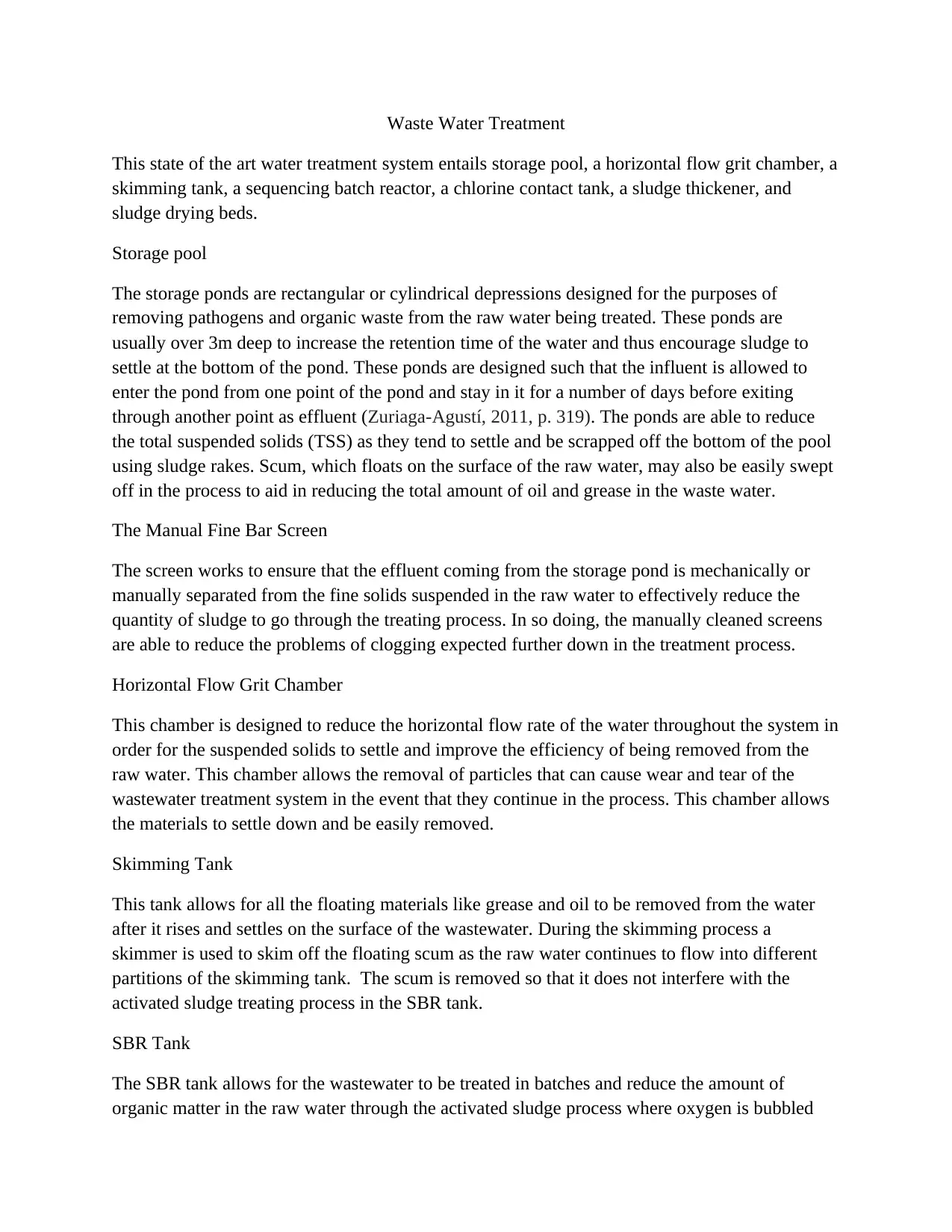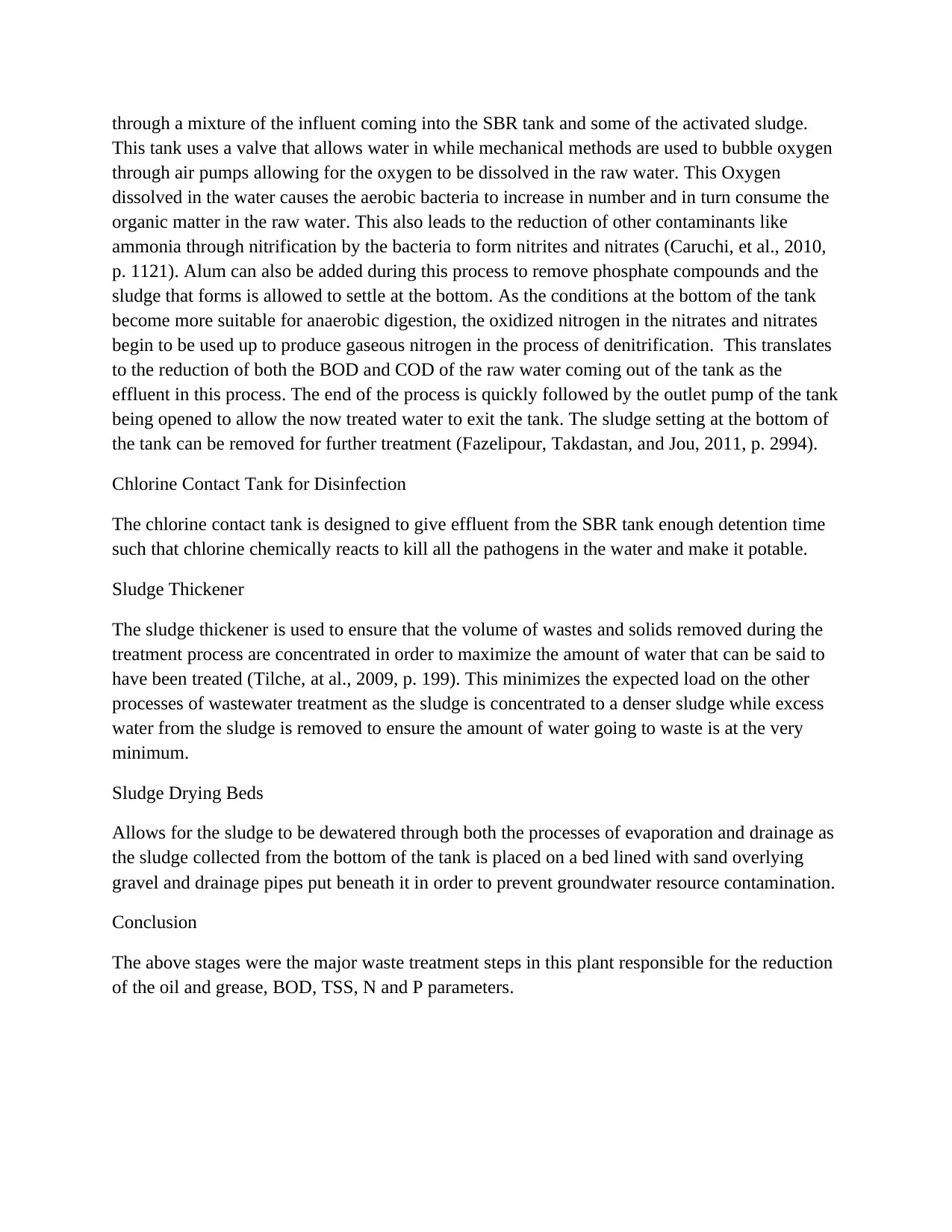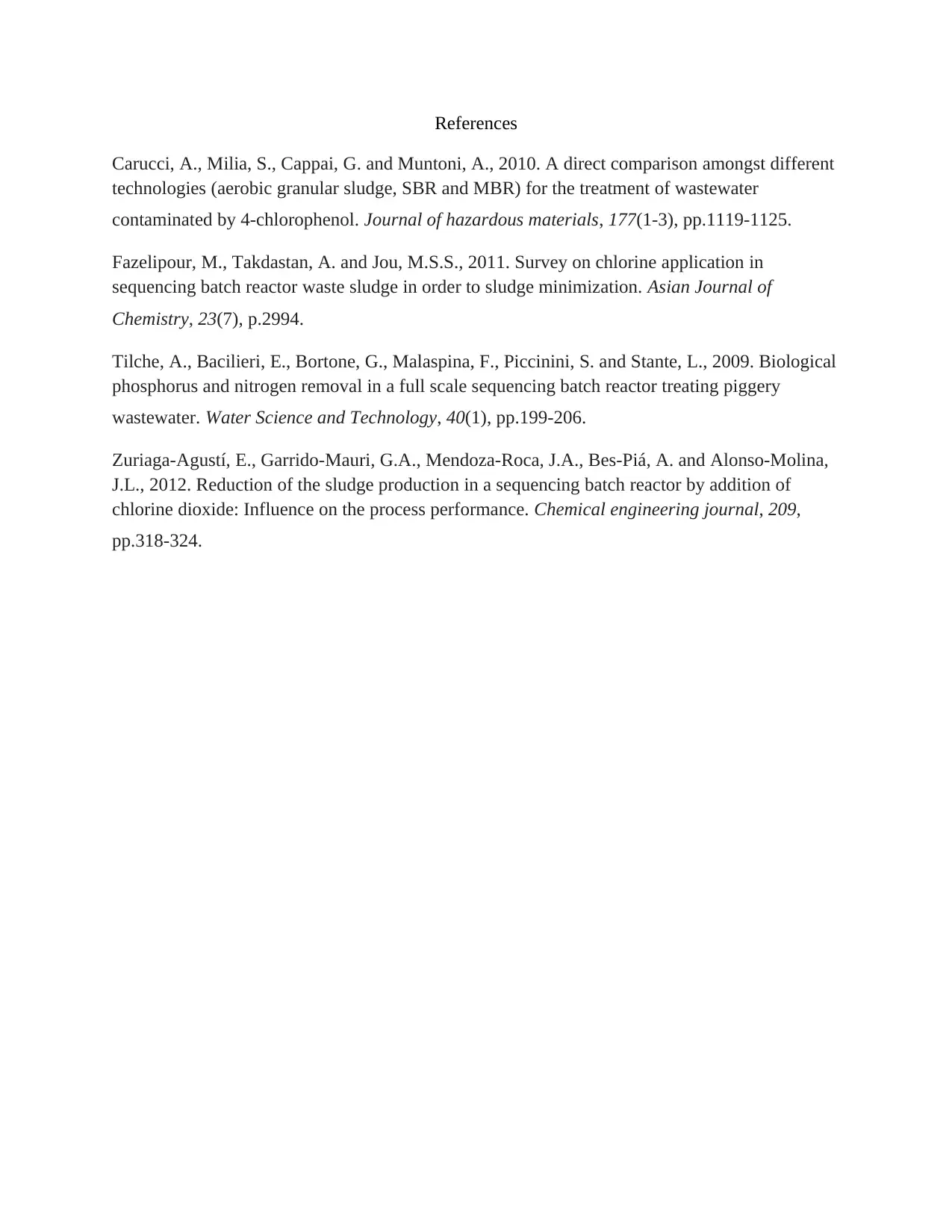Analysis of Waste Water Treatment System Components and Processes
VerifiedAdded on 2023/04/24
|5
|1162
|153
Report
AI Summary
This report provides a comprehensive overview of a state-of-the-art waste water treatment system, detailing its key components and processes. The system includes a storage pool for pathogen and organic waste removal, a manual fine bar screen for separating fine solids, a horizontal flow grit chamber for settling suspended solids, and a skimming tank for removing floating materials like grease and oil. The sequencing batch reactor (SBR) tank is a crucial element, treating wastewater in batches using activated sludge and oxygen to reduce organic matter, ammonia, and other contaminants. Following the SBR tank, a chlorine contact tank disinfects the effluent, ensuring it is potable. The system also incorporates a sludge thickener to concentrate waste and solids, and sludge drying beds for dewatering through evaporation and drainage. The report concludes that these stages are responsible for significantly reducing oil and grease, BOD, TSS, N, and P parameters in the waste water.

Waste Water Treatment
Name
Institution
Name
Institution
Paraphrase This Document
Need a fresh take? Get an instant paraphrase of this document with our AI Paraphraser

Waste Water Treatment
This state of the art water treatment system entails storage pool, a horizontal flow grit chamber, a
skimming tank, a sequencing batch reactor, a chlorine contact tank, a sludge thickener, and
sludge drying beds.
Storage pool
The storage ponds are rectangular or cylindrical depressions designed for the purposes of
removing pathogens and organic waste from the raw water being treated. These ponds are
usually over 3m deep to increase the retention time of the water and thus encourage sludge to
settle at the bottom of the pond. These ponds are designed such that the influent is allowed to
enter the pond from one point of the pond and stay in it for a number of days before exiting
through another point as effluent (Zuriaga-Agustí, 2011, p. 319). The ponds are able to reduce
the total suspended solids (TSS) as they tend to settle and be scrapped off the bottom of the pool
using sludge rakes. Scum, which floats on the surface of the raw water, may also be easily swept
off in the process to aid in reducing the total amount of oil and grease in the waste water.
The Manual Fine Bar Screen
The screen works to ensure that the effluent coming from the storage pond is mechanically or
manually separated from the fine solids suspended in the raw water to effectively reduce the
quantity of sludge to go through the treating process. In so doing, the manually cleaned screens
are able to reduce the problems of clogging expected further down in the treatment process.
Horizontal Flow Grit Chamber
This chamber is designed to reduce the horizontal flow rate of the water throughout the system in
order for the suspended solids to settle and improve the efficiency of being removed from the
raw water. This chamber allows the removal of particles that can cause wear and tear of the
wastewater treatment system in the event that they continue in the process. This chamber allows
the materials to settle down and be easily removed.
Skimming Tank
This tank allows for all the floating materials like grease and oil to be removed from the water
after it rises and settles on the surface of the wastewater. During the skimming process a
skimmer is used to skim off the floating scum as the raw water continues to flow into different
partitions of the skimming tank. The scum is removed so that it does not interfere with the
activated sludge treating process in the SBR tank.
SBR Tank
The SBR tank allows for the wastewater to be treated in batches and reduce the amount of
organic matter in the raw water through the activated sludge process where oxygen is bubbled
This state of the art water treatment system entails storage pool, a horizontal flow grit chamber, a
skimming tank, a sequencing batch reactor, a chlorine contact tank, a sludge thickener, and
sludge drying beds.
Storage pool
The storage ponds are rectangular or cylindrical depressions designed for the purposes of
removing pathogens and organic waste from the raw water being treated. These ponds are
usually over 3m deep to increase the retention time of the water and thus encourage sludge to
settle at the bottom of the pond. These ponds are designed such that the influent is allowed to
enter the pond from one point of the pond and stay in it for a number of days before exiting
through another point as effluent (Zuriaga-Agustí, 2011, p. 319). The ponds are able to reduce
the total suspended solids (TSS) as they tend to settle and be scrapped off the bottom of the pool
using sludge rakes. Scum, which floats on the surface of the raw water, may also be easily swept
off in the process to aid in reducing the total amount of oil and grease in the waste water.
The Manual Fine Bar Screen
The screen works to ensure that the effluent coming from the storage pond is mechanically or
manually separated from the fine solids suspended in the raw water to effectively reduce the
quantity of sludge to go through the treating process. In so doing, the manually cleaned screens
are able to reduce the problems of clogging expected further down in the treatment process.
Horizontal Flow Grit Chamber
This chamber is designed to reduce the horizontal flow rate of the water throughout the system in
order for the suspended solids to settle and improve the efficiency of being removed from the
raw water. This chamber allows the removal of particles that can cause wear and tear of the
wastewater treatment system in the event that they continue in the process. This chamber allows
the materials to settle down and be easily removed.
Skimming Tank
This tank allows for all the floating materials like grease and oil to be removed from the water
after it rises and settles on the surface of the wastewater. During the skimming process a
skimmer is used to skim off the floating scum as the raw water continues to flow into different
partitions of the skimming tank. The scum is removed so that it does not interfere with the
activated sludge treating process in the SBR tank.
SBR Tank
The SBR tank allows for the wastewater to be treated in batches and reduce the amount of
organic matter in the raw water through the activated sludge process where oxygen is bubbled

through a mixture of the influent coming into the SBR tank and some of the activated sludge.
This tank uses a valve that allows water in while mechanical methods are used to bubble oxygen
through air pumps allowing for the oxygen to be dissolved in the raw water. This Oxygen
dissolved in the water causes the aerobic bacteria to increase in number and in turn consume the
organic matter in the raw water. This also leads to the reduction of other contaminants like
ammonia through nitrification by the bacteria to form nitrites and nitrates (Caruchi, et al., 2010,
p. 1121). Alum can also be added during this process to remove phosphate compounds and the
sludge that forms is allowed to settle at the bottom. As the conditions at the bottom of the tank
become more suitable for anaerobic digestion, the oxidized nitrogen in the nitrates and nitrates
begin to be used up to produce gaseous nitrogen in the process of denitrification. This translates
to the reduction of both the BOD and COD of the raw water coming out of the tank as the
effluent in this process. The end of the process is quickly followed by the outlet pump of the tank
being opened to allow the now treated water to exit the tank. The sludge setting at the bottom of
the tank can be removed for further treatment (Fazelipour, Takdastan, and Jou, 2011, p. 2994).
Chlorine Contact Tank for Disinfection
The chlorine contact tank is designed to give effluent from the SBR tank enough detention time
such that chlorine chemically reacts to kill all the pathogens in the water and make it potable.
Sludge Thickener
The sludge thickener is used to ensure that the volume of wastes and solids removed during the
treatment process are concentrated in order to maximize the amount of water that can be said to
have been treated (Tilche, at al., 2009, p. 199). This minimizes the expected load on the other
processes of wastewater treatment as the sludge is concentrated to a denser sludge while excess
water from the sludge is removed to ensure the amount of water going to waste is at the very
minimum.
Sludge Drying Beds
Allows for the sludge to be dewatered through both the processes of evaporation and drainage as
the sludge collected from the bottom of the tank is placed on a bed lined with sand overlying
gravel and drainage pipes put beneath it in order to prevent groundwater resource contamination.
Conclusion
The above stages were the major waste treatment steps in this plant responsible for the reduction
of the oil and grease, BOD, TSS, N and P parameters.
This tank uses a valve that allows water in while mechanical methods are used to bubble oxygen
through air pumps allowing for the oxygen to be dissolved in the raw water. This Oxygen
dissolved in the water causes the aerobic bacteria to increase in number and in turn consume the
organic matter in the raw water. This also leads to the reduction of other contaminants like
ammonia through nitrification by the bacteria to form nitrites and nitrates (Caruchi, et al., 2010,
p. 1121). Alum can also be added during this process to remove phosphate compounds and the
sludge that forms is allowed to settle at the bottom. As the conditions at the bottom of the tank
become more suitable for anaerobic digestion, the oxidized nitrogen in the nitrates and nitrates
begin to be used up to produce gaseous nitrogen in the process of denitrification. This translates
to the reduction of both the BOD and COD of the raw water coming out of the tank as the
effluent in this process. The end of the process is quickly followed by the outlet pump of the tank
being opened to allow the now treated water to exit the tank. The sludge setting at the bottom of
the tank can be removed for further treatment (Fazelipour, Takdastan, and Jou, 2011, p. 2994).
Chlorine Contact Tank for Disinfection
The chlorine contact tank is designed to give effluent from the SBR tank enough detention time
such that chlorine chemically reacts to kill all the pathogens in the water and make it potable.
Sludge Thickener
The sludge thickener is used to ensure that the volume of wastes and solids removed during the
treatment process are concentrated in order to maximize the amount of water that can be said to
have been treated (Tilche, at al., 2009, p. 199). This minimizes the expected load on the other
processes of wastewater treatment as the sludge is concentrated to a denser sludge while excess
water from the sludge is removed to ensure the amount of water going to waste is at the very
minimum.
Sludge Drying Beds
Allows for the sludge to be dewatered through both the processes of evaporation and drainage as
the sludge collected from the bottom of the tank is placed on a bed lined with sand overlying
gravel and drainage pipes put beneath it in order to prevent groundwater resource contamination.
Conclusion
The above stages were the major waste treatment steps in this plant responsible for the reduction
of the oil and grease, BOD, TSS, N and P parameters.
⊘ This is a preview!⊘
Do you want full access?
Subscribe today to unlock all pages.

Trusted by 1+ million students worldwide

References
Carucci, A., Milia, S., Cappai, G. and Muntoni, A., 2010. A direct comparison amongst different
technologies (aerobic granular sludge, SBR and MBR) for the treatment of wastewater
contaminated by 4-chlorophenol. Journal of hazardous materials, 177(1-3), pp.1119-1125.
Fazelipour, M., Takdastan, A. and Jou, M.S.S., 2011. Survey on chlorine application in
sequencing batch reactor waste sludge in order to sludge minimization. Asian Journal of
Chemistry, 23(7), p.2994.
Tilche, A., Bacilieri, E., Bortone, G., Malaspina, F., Piccinini, S. and Stante, L., 2009. Biological
phosphorus and nitrogen removal in a full scale sequencing batch reactor treating piggery
wastewater. Water Science and Technology, 40(1), pp.199-206.
Zuriaga-Agustí, E., Garrido-Mauri, G.A., Mendoza-Roca, J.A., Bes-Piá, A. and Alonso-Molina,
J.L., 2012. Reduction of the sludge production in a sequencing batch reactor by addition of
chlorine dioxide: Influence on the process performance. Chemical engineering journal, 209,
pp.318-324.
Carucci, A., Milia, S., Cappai, G. and Muntoni, A., 2010. A direct comparison amongst different
technologies (aerobic granular sludge, SBR and MBR) for the treatment of wastewater
contaminated by 4-chlorophenol. Journal of hazardous materials, 177(1-3), pp.1119-1125.
Fazelipour, M., Takdastan, A. and Jou, M.S.S., 2011. Survey on chlorine application in
sequencing batch reactor waste sludge in order to sludge minimization. Asian Journal of
Chemistry, 23(7), p.2994.
Tilche, A., Bacilieri, E., Bortone, G., Malaspina, F., Piccinini, S. and Stante, L., 2009. Biological
phosphorus and nitrogen removal in a full scale sequencing batch reactor treating piggery
wastewater. Water Science and Technology, 40(1), pp.199-206.
Zuriaga-Agustí, E., Garrido-Mauri, G.A., Mendoza-Roca, J.A., Bes-Piá, A. and Alonso-Molina,
J.L., 2012. Reduction of the sludge production in a sequencing batch reactor by addition of
chlorine dioxide: Influence on the process performance. Chemical engineering journal, 209,
pp.318-324.
Paraphrase This Document
Need a fresh take? Get an instant paraphrase of this document with our AI Paraphraser

1 out of 5
Related Documents
Your All-in-One AI-Powered Toolkit for Academic Success.
+13062052269
info@desklib.com
Available 24*7 on WhatsApp / Email
![[object Object]](/_next/static/media/star-bottom.7253800d.svg)
Unlock your academic potential
Copyright © 2020–2025 A2Z Services. All Rights Reserved. Developed and managed by ZUCOL.





